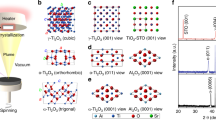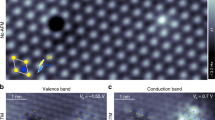Abstract
Oxide-supported transition-metal clusters and nanoparticles have attracted significant attention owing to their important role as components of model catalysts1,2,3,4,5,6, sensors7, solar cells8 and magnetic recording devices9. For small clusters, functionality and structure are closely interrelated. However, knowledge of the structure of the bare cluster is insufficient as the interaction with the chemical environment might cause drastic structural changes. Here we show by ab initio simulations based on the density functional theory that the reaction with molecular oxygen transforms small, non-crystalline, magnesia-supported Pd-clusters to crystalline PdxOy nano-oxide clusters that are in epitaxy with the underlying support. Restructuring of the Pd backbone is controlled by the electrostatic interaction with magnesia leading to a strong reduction of the O2 dissociation barrier. The supported PdxOy clusters are likely to serve as Mars–van Krevelen10 oxygen reservoirs in catalytic oxidation reactions as observed for PdO overlayers11 and demonstrated here for the oxidation of CO molecules.
This is a preview of subscription content, access via your institution
Access options
Subscribe to this journal
Receive 12 print issues and online access
$259.00 per year
only $21.58 per issue
Buy this article
- Purchase on Springer Link
- Instant access to full article PDF
Prices may be subject to local taxes which are calculated during checkout



Similar content being viewed by others
References
Lambert, R. M. & Pacchioni, G. (eds) Chemisorption and Reactivity on Supported Clusters and Thin Films 395–424 (Kluwer, Dordrecht, 1997).
Grönbeck, H. First principles studies of metal-oxide surfaces. Top. Catal. 28, 59–69 (2004).
Heiz, U. & Schneider, W.-D. in Metal Clusters at Surfaces (ed. Meiwes-Broer, K. H.) 237–273 (Springer, Berlin, 2000).
Becker, C. & Henry, C. R. Cluster size dependent kinetics for the oxidation of CO on Pd/MgO(100) model catalyst. Surf. Sci. 352, 457–462 (1996).
Freund, H. J. Catalysis and surface science: What do we learn from studies of oxide-supported cluster model systems. Adv. Catal. 45, 333–384 (2000).
Shaikhutdinov, S. H. et al. Interaction of oxygen with palladium deposited on a thin alumina film. Surf. Sci. 501, 270–281 (2002).
Mizsei, J., Voutilainen, J., Saukko, S. & Lantto, V. Structural transformations of ultra-thin sputtered Pd activator layers on glass and SnO2 surfaces. Thin Solid Films 391, 209–215 (2001).
Westphalen, M., Kreibig, U., Rostalski, J., Luth, H. & Meissner, D. Metal cluster enhanced organic solar cells. Solar Energy Mater. Solar Cells 61, 97–105 (2000).
Fukami, S., Ohno, A. & Tanaka, A. HRTEM and EELS studies of L1(0)-ordered FePt nano-clusters on MgO films prepared below 673 K. Mater. Trans. 45, 2012–2017 (2004).
Mars, P. & van Krevelen, D. W. Oxidations carried out by means of vanadium oxide catalysts. Chem. Eng. Sci. 3, 41–59 (1954).
Hendriksen, B. L. M., Bobaru, S. C. & Frenken, J. W. M. Oscillatory CO oxidation on Pd(100) studied with in situ scanning tunnelling microscopy. Surf. Sci. 552, 229–242 (2004).
Haberland, H. (ed.) Cluster of Atoms and Molecules (Springer, Berlin, 1994).
Hammer, B. & Norskov, J. K. in Chemisorption and Reactivity on Supported Clusters and Thin Films (eds Lambert, R. M. & Pacchioni, G.) 331–351 (Kluwer, Dordrecht, 1997).
Moseler, M., Häkkinen, H., Barnett, R. N. & Landman, U. Structure and magnetism of neutral and anionic Pd clusters. Phys. Rev. Lett. 86, 2545–2548 (2001).
Moseler, M., Häkkinen, H. & Landman, U. Supported magnetic nanoclusters: Softlanding of Pd clusters on a MgO(100) surface. Phys. Rev. Lett. 89, 176103 (2002).
Abbet, S., Heiz, U., Häkkinen, H. & Landman, U. CO oxidation on a single Pd atom supported on magnesia. Phys. Rev. Lett. 86, 5950–5953 (2001).
Abbet, S. et al. Identification of defect sites on MgO(100) thin films by decoration with Pd atoms and studying CO adsorption properties. J. Am. Chem. Soc. 123, 6172–6178 (2000).
Eichler, A., Mittendorfer, F. & Hafner, J. Precursor-mediated adsorption of oxygen on the (111) surfaces of platinum-group metals. Phys. Rev. B 62, 4744–4755 (2000).
Huber, B., Häkkinen, H., Landman, U. & Moseler, M. Oxidation of small gas phase Pd clusters: A density functional study. Comput. Mater. Sci. (in the press).
Lundgren, E. et al. Two-dimensional oxide on Pd(111). Phys. Rev. Lett. 88, 246103 (2002).
Todorova, M. et al. The Pd(100)-√5×√5R27∘-O surface oxide revisited. Surf. Sci. 541, 101–112 (2003).
Heiz, U. & Bullock, E. L. Fundamental aspects of catalysis on supported metal clusters. Mater. Chem. 14, 564–577 (2004).
Zang, C. J. & Hu, P. J. CO oxidation on Pd(100) and Pd(111): A comparative study of reaction pathways and reactivity at low and medium coverages. Am. Chem. Soc. 123, 1166–1172 (2001).
Heiz, U., Sanchez, A. & Abbet, S. Tuning the oxidation of carbon monoxide using nanoassembled model catalysts. Chem. Phys. 262, 189–200 (2000).
Barnett, R. N. & Landman, U. Born-Oppenheimer molecular-dynamics simulations of finite systems: Structure and dynamics of (H2O)2 . Phys. Rev. B 48, 2081–2097 (1993).
Perdew, J. P., Burke, K. & Ernzerhof, M. Generalized gradient approximation made simple. Phys. Rev. Lett. 77, 3865–3868 (1996).
Troullier, N. & Martins, J. L. Efficient pseudopotentials for plane-wave calculations. Phys. Rev. B 43, 1993–2006 (1991).
Henkelman, G. & Jonsson, H. Improved tangent estimate in the nudged elastic band method for finding minimum energy paths and saddle points. J. Chem. Phys. 113, 9978–9985 (2000).
Richards, F. M. The interpretation of protein structures: Total volume, group volume distributions and packing density. J. Mol. Biol. 82, 1–14 (1974).
Tersoff, J. & Hamann, R. Theory of the scanning tunneling microscope. Phys. Rev. Lett. 50, 1998–2001 (1983).
Acknowledgements
We thank U. Heiz for the communication of unpublished results and fruitful discussions. This work was supported by the Deutsche Forschungsgemeinschaft within SPP 1153, the Fraunhofer MAVO for Multiscale Materials Modelling (MMM) and the Academy of Finland (AF). M.M. and H.H. acknowledge the DAAD-AF bilateral travel grant for the project ‘Supported Metal Clusters and Nanoparticles: Electronic Structure, Optical Properties and Nanocatalysis’. Computations were performed at NIC in Jülich, Germany, and at the CSC—the Finnish IT Center for Science in Espoo, Finland.
Author information
Authors and Affiliations
Corresponding author
Ethics declarations
Competing interests
The authors declare no competing financial interests.
Supplementary information
Supplementary Information
Supplementary information and figure S1 (PDF 100 kb)
Rights and permissions
About this article
Cite this article
Huber, B., Koskinen, P., Häkkinen, H. et al. Oxidation of magnesia-supported Pd-clusters leads to the ultimate limit of epitaxy with a catalytic function. Nature Mater 5, 44–47 (2006). https://doi.org/10.1038/nmat1533
Received:
Accepted:
Published:
Issue Date:
DOI: https://doi.org/10.1038/nmat1533
This article is cited by
-
New monatomic layer clusters for advanced catalysis materials
Science China Materials (2019)
-
Catalysis by clusters with precise numbers of atoms
Nature Nanotechnology (2015)
-
Dynamic in situ observation of rapid size and shape change of supported Pd nanoparticles during CO/NO cycling
Nature Materials (2007)



